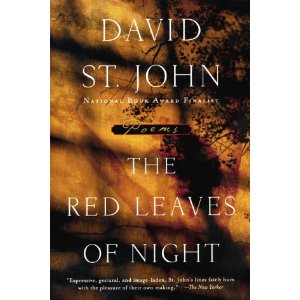
[Editor’s note: We’re happy to announce that Timothy Otte, curator of our new Calendar of (Un)Deadlines, will be contributing to our What We’re Reading series! Look for his posts once a month.]
 When I agreed to contribute to Hazel & Wren’s What We’re Reading feature I thought I would write my inaugural post about my mentor, Jennifer Kwon Dobbs. I’m often intrigued by lineage of influence, the people who influenced the people who influence us, so she seemed like a logical choice. However, I had just purchased a collection of poems by one of Jennifer’s mentors, David St. John, whose work I had never read, but whose stamp is undoubtedly on her writing. Even better.
When I agreed to contribute to Hazel & Wren’s What We’re Reading feature I thought I would write my inaugural post about my mentor, Jennifer Kwon Dobbs. I’m often intrigued by lineage of influence, the people who influenced the people who influence us, so she seemed like a logical choice. However, I had just purchased a collection of poems by one of Jennifer’s mentors, David St. John, whose work I had never read, but whose stamp is undoubtedly on her writing. Even better.
The Red Leaves of Night (HarperPerennial, 1999) is not St. John’s most recent collection, nor is it his most well known. In fact, it’s not even mentioned in his biography on Poets.org. It is, however, a collection of vivid and well crafted poems.
The poetry in this collection has a formal quality to it while remaining wholly contemporary. “Rhapsody” is a riff on a sonnet, “Nocturnes & Aubades” is a cycle of 18 poems that, as the title suggests, shifts between night and morning, but never comes full circle as would a traditional cycle. That’s not to say it isn’t satisfying. Indeed, the 14th poem in the cycle, “At the Lake,” is a heartbreaking look at the differences between sex and intimacy that I’ve reread a number of times.
While St. John draws from formal conventions, he often eschews such trivialities as punctuation, guiding the reader through his words with a light touch, leaving us to parse the occasionally complex syntax on our own. In “What He Said” the narrator’s voice and the voice of the man to whom the title refers are separated by a thin line:
My friend said to me
The one thing I’d never do
Is to sleep with another man’s
Wife no actually he didn’t say
“Another man’s” he said instead
“A friend’s” meaning I suppose me
Punctuation, as it is used in St. John’s work, nudges the reader in the right direction and is used only when necessary, and sometimes not even then.
What is necessary in St. John’s poetry is visceral language that evokes all of the senses. The body is vividly portrayed in The Red Leaves of Night and the poems are often sensual but never become overly erotic.The body/self in St. John’s poetry is used as a device to further an idea rather than as an object to be lusted after. In “Two” he writes of a woman walking naked through her house: “that resolute fierceness in her stride // & the erect pride of her scarlet nipples[…]”. Throughout this collection the outer vessel is used to enact an inner confidence that is sexual and palpable.
As far as poetic grandparents go, David St. John isn’t a bad one to have. I can see the influence he has had on Jennifer in everything from form to typeface, all of which has, consciously or not, influenced me. My own work often explores the body, sensuality and sexuality, so in St. John I’ve found someone from whom I can learn. It’s clear in The Red Leaves of Night that St. John enjoys writing poems, which means they’re pleasurable to read. Though this is a complex collection, finding one’s way through them to understanding is a satisfying experience.





